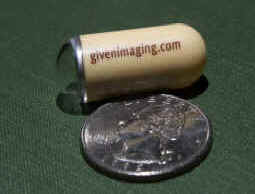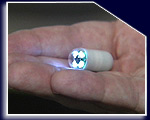The Camera Pill
A High-tech Detective?
The Given Diagnostic Imaging System, made by Given Imaging Ltd. (Norcross, Georgia) is a capsule, a little more than an inch long and a little less than a half inch wide; it contains a tiny video camera, a light, a transmitter, and batteries. The capsule is swallowed by the patient, then passes through the digestive tract where it takes video pictures of the small intestine (small bowel) and transmits them via radio signals to a small recorder attached to the patient's belt. The images can then be evaluated by the physician. The non-reusable capsule is as easily swallowed as common capsules and passes out of the body during normal defecation within 8 to 72 hours.
 The
clinical use for this device is visualization of the interior of the small
intestine when there is chronic or unexplained rectal bleeding, or blood in the
stool, and when small bowel disease, cancer, or polyps are a concern. This
procedure should only be used after the patient has received other imaging
procedures to visualize the inside of the small bowel.
The
clinical use for this device is visualization of the interior of the small
intestine when there is chronic or unexplained rectal bleeding, or blood in the
stool, and when small bowel disease, cancer, or polyps are a concern. This
procedure should only be used after the patient has received other imaging
procedures to visualize the inside of the small bowel.
Currently, the standard method for detecting abnormalities in the intestines is endoscopy in which the doctor advances a scope down into the small intestine via the mouth. It is important to note, however, that endoscopes can only reach the upper part of the small bowel, providing only a partial view, whereas the camera visualizes the entire length of the small bowel.
Acupuncture
Adult Day Care
Allergy & Asthma
Alternative Medicine
Assisted Living
Audiology
Chiropractic
Clinical Research
Community Health
Cosmetic Surgery
Dental Care
Dermatology
Endodontist
Family Practice
Fertility
Gastroenterology
Health Insurance
Home Care
Hospice
Hospitals
Hypnotherapy
Imaging
Internal Medicine
Laboratory
Laser & Botox
Medical Supplies
Neurology
Obstetrics & Gynecology
Ophthalmology
Optometry
Orthodontics
Orthopedic Surgery
Pain management
Parenthood
Pediatric Dentistry
Pediatrics
Pharmacy
Physical Medicine
Physical Therapy
Plastic Surgery
Podiatry
Psychology
Rehabilitation
Retirement Community
Skilled Nursing
Skin Care
Speech Pathology
Sports Medicine
Urgent Care
Urinary Continence
Urogynecology
Weight Loss
There are circumstances under which the camera cannot be used: in patients who have cardiac pacemakers or other implanted electromagnetic devices; and in patients who have an intestinal blockage, a significantly narrowed small bowel, or an abnormal connection between the bowel and another organ. Prior to using the camera for diagnoses, an x-ray exam of the small bowel should be done if there is concern that the small bowel may be too narrow for the camera to pass through it.
While
the camera is inside the body, the patient should avoid bending, or stooping, or
engaging in any vigorous movement, and avoid coming too close to devices that
may cause electromagnetic interference such as mobile radios or MRI machines.
These may cause the video pictures taken by the camera to be lost.
In
one of the human trials, Given Imaging studied the use of the camera capsule in
patients with suspected small intestine disease. All of these patients had signs
of either unexplained chronic gastrointestinal blood loss or anemia and all had
undergone standard endoscopic and radiological evaluations prior to use of the
camera capsule. Study results showed that the camera pill was safe and
effective—there were no side effects and the pill was able to detect
abnormalities in the parts of the small intestine not reached by the endoscope.
NOTE:
This device is intended for complementary use with—not as a replacement
for—other endoscopic and radiological evaluations of the small bowel.

Articles Provided by Given Imaging
Ltd.